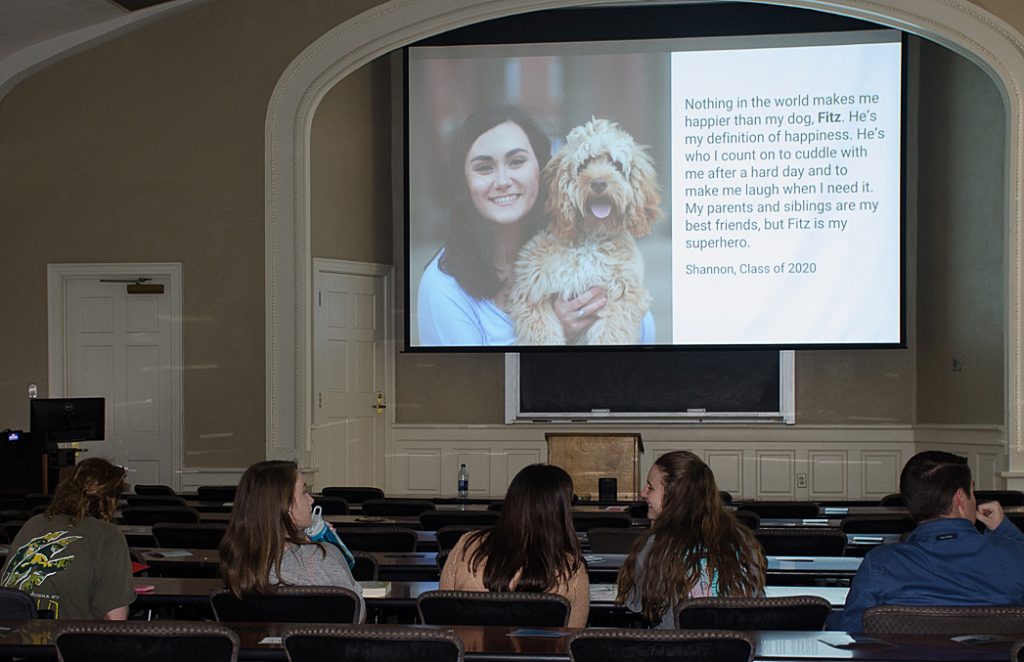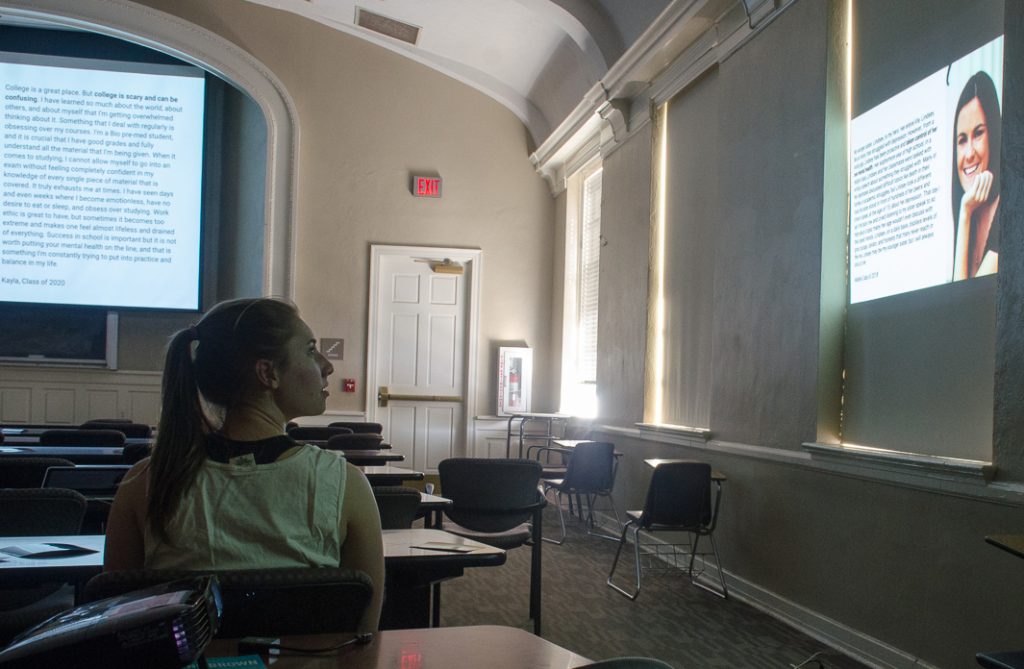Student group Active Minds showcased several past and present students who have dealt with mental health issues, intense struggles and stressors with their “Humans of Ole Miss” exhibit Tuesday. The event was part of the group’s Mental Health Week on campus.
Students shared their stories at the exhibit, detailing the obstacles they have and continue to face and how they propel themselves forward. Pictures and stories were shown on a rotating display by projectors around the room, in addition to print photos and cards of inspiration.
“With ‘Humans of Ole Miss,’ we wanted to bring to light some of the things that people have put away and that initially they felt like they couldn’t talk about,” said Sarah Byron, Active Minds member.
Byron, a photographer, used her lens to capture the changing narrative of mental health as told at the event.

Students learn about mental health through stories of fellow students at the Humans of Ole Miss event in Bondurant Hall on Tuesday, part of Mental Health Awareness week. Photo by Hannah Hurdle
Byron is one of many students who are part of Active Minds’ work on campus, dedicated to fighting stigmas and promoting mental health awareness and education for college students.
“We wanted to showcase their faces in order to break the stigma,” Byron said. “It is really powerful because we have known these people, but we did not the extent of what they have gone through.”
More than 40 million Americans live with a mental health condition, a number that is more than the populations of New York and Florida combined. Event organizers hoped the exhibit could provide insight to the fact that mental health issues affect a wide range of people from various walks of life.
“This event is specifically about showing people that is not about your age, race, gender, sexuality, religious orientation or country of origin,” Active Minds member Josh Martin said. “Everyone has things that they have been through.”
Mental health issues affect Americans of many ages and studies show adults ages 18-24 years old show the lowest rate of help-seeking.
“Last semester, I was in an abusive relationship, and in late January, I experienced a similar incident, so I decided that it was imperative that I seek help,” Leah Davis said.
Davis is a current student living with acute anxiety and depression that stems from post-traumatic stress disorder.
In order to increase the number of students who are help-seeking at the university, Active Minds invited the University Counseling Center to come and speak about its programs and services. The center offers free services to students through several different methods such as one-on-one consultation and group therapy.

Katie Davis learns about mental health through photos with testimonials during the Humans of Ole Miss exhibit in Bondurant Hall on Tuesday, part of Mental Health Awareness week. Photo by Hannah Hurdle
For many students dealing with mental health struggles, stigmatization of the issue at hand by fellow peers or administration can turn students away from seeking help or being vulnerable.
“‘Stigma’ is a broad term and can apply to many issues,” Martin said. “With mental health, it can be as simple as saying ‘This homework sucks. It makes me want to cut myself.’ That is taking a very serious issue and turning it into a joke that is not funny.”
According to the Active Minds national website, more than 1,000 college students are lost to suicide each year. Sixty-seven percent of college students tell a friend they are feeling suicidal before telling anyone else.
“Let them know that it is OK to come to you for problems,” Martin said. “Let them know what resources they have available to them while also not treating them any differently. Treat them with care and respect.”
Tuesday’s event highlighted the range of stressors that may come from being in college. Many students deal with paying for their own education. Others have trouble finding themselves. Some are intimidated by the temptations and dangers of a college campus. There are various reasons why students experience stress during college, all of which can be reasons for a student’s mental state to be challenged or compromised.
“The stigma that surrounds mental illnesses on college campuses often creates a great deal of pressure that can be very overwhelming,” Davis said. “I think it was just due to the pressure of classes and the social pressure as well. College is very fast-paced, and it forces you to take on adult decisions and scenarios during a very sharp transition.”






